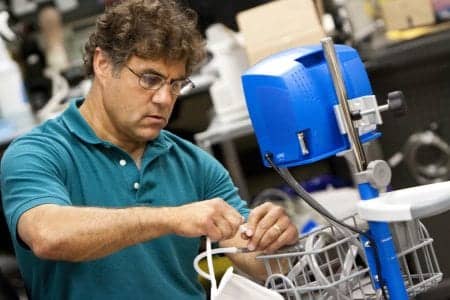
Senior Biomed Technician Dave Angie repairs a vital signs monitor.
As a clinical engineering director at a major urban hospital, Donald DiVita, University of Rochester Medical Center (URMC), Rochester, NY, has seen his share of talented technicians fly the coop for more lucrative jobs. Waiting for someone to leave or retire, it turns out, is not the ideal way to reach the better-paid heights of senior technician.
DiVita and senior staff members avoid occupational exodus situations with a comprehensive career ladder that places knowledge and talent ahead of seniority. Instead of a finite number of senior slots, those who have what it takes can climb a set number of steps to qualify for upper echelon status. “People would get all this service training from us, and, in the past, we could not offer promotions because there were only so many people we could elevate to another job level,” DiVita says. “We were spending about $135K a year to train our technical staff only to have these people get up and go someplace else. How about supporting these people with a career ladder?”
The plan worked, ultimately keeping valued technicians on the payroll and enthusiastic about their position. Good clinical engineering techs in the industry routinely eye the job boards, so any way to restrain this roving eye is bound to attract attention. Such was the case when officials from the Virginia-based Association for the Advancement of Medical Instrumentation recognized the career ladder with a coveted best practice award. “We now evaluate technicians based on what they know and promote them accordingly,” DiVita says.
Offering an unlimited number of senior slots is not an inexpensive proposition, and naysayers point to what they believe are lower costs for traditional stratified setups. After 35 years in the clinical engineering field, DiVita doesn’t buy it. Instead, he believes that turnover, retraining, and meshing new personalities into the system are all potential land mines with their own challenges. “As people turn over, it costs you more money,” DiVita says. “You want to keep the staff that are good performers, because you have investments in training with time and dollars. We would like to be able to keep those staff people for as long as possible. The way to make staff want to stay in the department is to give them an opportunity to get promoted and be recognized.”

Clockwise, from bottom left, the URMC clinical engineering leadership team: Donald DiVita, clinical engineering director; Stan Philips, biomed team leader; Nils Gurdin, project manager; Bill Vidro, imaging team leader; and Eileen Cowie, biomed team leader.
Offering an unlimited number of senior slots is not an inexpensive proposition, and naysayers point to what they believe are lower costs for traditional stratified setups. After 35 years in the clinical engineering field, DiVita doesn’t buy it. Instead, he believes that turnover, retraining, and meshing new personalities into the system are all potential land mines with their own challenges. “As people turn over, it costs you more money,” DiVita says. “You want to keep the staff that are good performers, because you have investments in training with time and dollars. We would like to be able to keep those staff people for as long as possible. The way to make staff want to stay in the department is to give them an opportunity to get promoted and be recognized.”
HR GETS IN ON THE ACT
The sprawling URMC includes Strong Memorial, Highland, Golisano Children’s Hospital, Eastman Dental, a visiting nurse service, and two skilled nursing facilities. The in-house clinical engineering services department encompasses 35 individuals, which includes clerical and parts staff. The department also has a biomedical and imaging engineering section.
With more than 35,000 pieces of equipment to care for, the operation amounts to a sizable technical and managerial challenge. It is a fast-paced environment where filling vacant positions and training new employees can slow things down. These days, DiVita reduces bothersome resignations by pointing new and talented employees to a road map for promotion.
Ed Inzana, a biomedical engineering technician II with 2 years at URMC, is a relative newcomer who appreciates the objective approach. “In the past, junior technicians had to wait until someone else left,” Inzana says. “In theory, we could have a shop of all senior technicians at some point. Other promotion processes are subjective, and leave a lot of room for uncertainty.”
Inzana’s own path to advancement started with a system that resembled the US Air Force’s cradle-to-grave personnel training record, a format that URMC team leader Stan Phillips believes could serve as a model that the department could modify as needed. The moment Inzana came in the door, all classes and equipment categories were outlined on paper, along with a clear list of required competencies.
The process quickly expanded beyond departmental confines to include formal input from human resources (HR) officials, who worked with clinical engineering leadership to update all technical job descriptions. “Each tech has his own copy of the career ladder documentation,” Inzana says. “It’s great having a document sitting in front of you, essentially leading you in the direction of what you need to get promoted. It motivates you to do your best and excel, and keep getting promoted.”
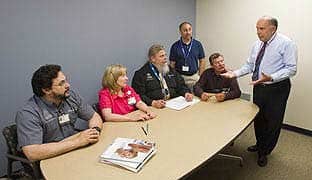
L-R: The clinical engineering leadership group—Stan Philips, Eileen Cowie, Nils Gurdin, Bill Vidro, and Donald DiVita (standing),—discuss procedures with Ed Inzana, biomed technician II (standing, rear).
Job classifications within the university system changed to mirror the new approach. Specifically, the occupational moniker of “research technician” has been modified to reflect the clinical engineering technician’s distinct skill set. A new documentation and tracking system formalized the training and advancement requirements into a detailed list for promotion from BMET I to BMET IV and imaging engineering tech I to IV.
Working with HR officials, two documents called the “Career Field Training and Promotion Guidelines” (or career ladder) emerged—one for biomed section staff, and one for imaging engineering staff. The team regrouped equipment types into about 80 classes, and defined training and competency requirements for each type of equipment.
MAXIMIZING LABOR RESOURCES
An extension of creating training and competency requirements is the goal to bring more service in-house. URMC used to have all infusion pumps on a service contract with the vendor. The department developed a bench technician position that has specific responsibilities to service lower-level tech equipment at a lower pay grade. The full-time bench technician stays in the shop and has the responsibility of infusion pumps, syringe pumps, and Gaymar T/Pumps. It is all part of a concerted effort to use OEM contracts as little as possible.

John Vay, biomed technician II, inspects an incubator.
Also moving this effort forward is the department’s collaboration with the bachelor’s-level biomedical engineering program at the University of Rochester. Students in that program work part time at URMC and earn a salary above the minimum wage. They do not receive benefits, but the students gain valuable experience working on a variety of clinical devices—which allows senior technicians to spend their time working on higher-end equipment.
“Students get a huge benefit working on equipment for 1 or 2 years, and it helps them get a job,” Phillips says, a 30-year biomed veteran with 13 years logged at URMC. “It’s all part of our goal to use the OEM as little as possible. We can do things cheaper than the OEM. For example, in the late 1990s, we took over all anesthesia service. We don’t charge labor back to our customers. The OEM was charging over $150 per hour to come in and work on anesthesia machines, so it was pure economics.”
Pure economics has fueled nothing less than an in-house revolution across the industry. Despite this trend, URMC still relies on some equipment manufacturers—at least for now. The specialty area of clinical lab equipment, for example, requires specially trained personnel that must cover after hours. “We have talked to clinical lab administration, and they are willing to let us take on their equipment with the caveat that we can do it right,” DiVita says. “We already service all the blood gas equipment in-house, so we have experience, and we can build on that to convince the lab that in-house staff can be successful servicing clinical lab equipment and gain their confidence.”
The Eastman Dental School at U of R represents yet another area for biomed expansion, and it may not be long before DiVita’s staff is tackling dental chairs and handpieces. “The vendors are willing to train in-house staff that have the experience and education to work on their equipment,” DiVita says. “Our plan is to work with Eastman Dental to eventually take full responsibility for the service of all their dental equipment.”
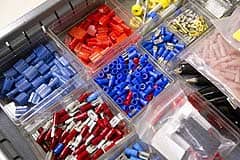
Miscellaneous spare parts used in the repair of equipment find an orderly home in the new department space.
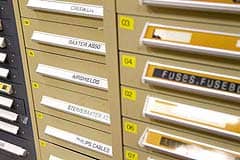
One of many spare parts cabinets in the department’s recently renovated space.

Spare parts neatly stored in the newly renovated department space—that cost more than $1 million—at Strong Memorial.
It is an ambitious plan, but one that DiVita believes is merited due to today’s health care environment. Like other cash-strapped states, New York is running a budget deficit, and the new governor wants to minimize tax increases. The likely remedy will be to reduce Medicaid reimbursement, a move that will inevitably lower hospital revenue.
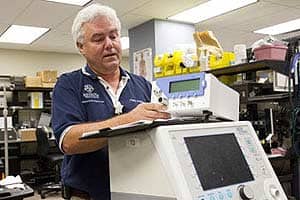
Marty Loftis, senior biomed technician, working on a ventilator inspection.
If the clinical engineering department wishes to increase pay and reward climbers on the career ladder—while the institution continues to build buildings and purchase pharmaceuticals and equipment—the money must come from somewhere. As a consolidated service model, dollars flow from clinical engineering’s $8 million budget whether the department (or the OEM) handles it or not. The budget tally includes salary/benefits—about 20%—with the rest for managing equipment service and preventive maintenance (PM). “If you cut reimbursement and you can’t make it up with patient volume, you are going to have to reduce your expenses,” DiVita says of the multimillion-dollar budget. “We have become a cost-avoidance department, and it’s even more critical for us to do our job better. From a service perspective, we can keep the hospital from having to spend more money, and that is why we have been successful. We had a budget reduction this year, so we had to determine how we could take over more without adding any more staff—or do it cheaper than the vendor. That is how a clinical engineering department can add value in this health care environment.”
DiVita encourages all staff members to look for ways to cut costs and maintain quality. Even the sacred “PM” does not avoid scrutiny. Marty Loftis, senior biomedical engineering technician, reveals that a departmental PM review committee will not hesitate to change processes that no longer make sense. “We are constantly looking at our PMs, and that can include changing a PM, or possibly removing a piece of equipment from the PM rotation,” he says. “We go into our database, and if we have not seen a problem in 2 years with that piece of equipment, then we will poll everybody on the committee to see if it is a valid piece to remove from PM. Obviously, it is not going to be a life support or anything like that. This has helped with our workload, while still maintaining a high level of service for the user and safety for the patient.”

Biomed Bench Tech/Parts Coordinator Sean Melder prepares new ventilators for initial inspections.
Despite ever-present cost pressures, senior leadership’s support of clinical engineering is solid, as evidenced by a newly renovated department space at Strong Memorial, which cost just over $1 million. “We are in a fantastic facility, and I do not believe they would have gone to these measures if they did not find value with us,” says Larry Sinsebox, an imaging engineering technician at URMC with 23 years on the job. “They have always budgeted necessary training dollars for the techs in this department. We may not be a revenue-generating department, but cost reduction adds to the net in the exact same way. Leadership realizes this, and that makes us excited to work for them.”
It also happens that officials at the top do not require clinical engineering to tackle security badges, satellite TV, and other nonclinical devices. DiVita and his staff know that other clinical engineering departments across the country are not so lucky, and they appreciate that senior leadership keeps these realms separate—allowing clinical engineering to focus on work that benefits patient care.
Smaller gestures, such as attending social functions, also go a long way toward fostering trust. “We recently had a Hawaiian day function, and senior leadership was invited, and in a lot of places senior leadership would pass on that and say they don’t have time, but they made a point to attend,” Loftis says. “For me, that’s a morale booster that they care enough and remember your name. At a place this big, to have the CEO join us for lunch is an example of how senior leadership supports and recognizes the clinical engineering department here.”

L-R: Marty Loftis, senior biomed technician, and Donald DiVita work on a ventilator inspection.
EFFECTIVE METHODS
Challenges in the budget process always include tough decisions regarding training resources, and URMC is no different. Training personnel to get ever-more equipment serviced by in-house staff is the preferred method, but not always.
In the case of newly purchased digital mammography systems, a service history review determined that a full service contract was the most cost-effective method for maintenance. “We have six of these in our system, and we pay roughly $50,000 per machine to keep these on service contract,” Sinsebox explains. “At first glance, it would be a great way to save $300,000 per year, but we seem to need a detector replaced on each system every 12 months, and these detectors cost $90,000. Quite simply, we will not pull the service into our shop—even if the techs want to—because it would be more expensive.”
OEMs handle endoscopes and MRI, while the nurse call system warrants a first pass from the facilities department. In several months, the biomed section staff will handle the second-pass service response on nurse call, along with IT, due to the heavily computerized nature of the call system. Facilities will remain in charge of the first-pass response.
As for the overall relationship with IT, Sinsebox says there are still “gray areas,” with clinical engineering not content to sit idly by and wait to determine who handles what. “Our staff is wellversed in the IT environments, and often we will assume responsibility for those borderline areas,” Sinsebox says. “An example would be our myelograph room. There is a workstation computer in there that interfaces the modality to the PACS network. In this system, if the workstation cannot push to PACS, the system will not operate properly. It went down one night, and clinical engineering troubleshot the issue and found a defective hard disk drive in the interface computer.
“The imaging equipment vendor could not get the needed part to us sooner than 3 days,” Sinsebox continues. “I and another technician went to IT and found a retired drive with the same specifications on it. We installed it in the computer, wiped clean the three partitions currently on it, and reloaded the operating system, application software, and license files—while redoing all the DICOM settings. We got the workstation working again the same day the problem was first exhibited.”
Sinsebox and his staff members worked well into the night to complete the task, and physicians did not have to cancel any of the 10 cases they had scheduled for the next day. Without the cancellations, patients and clinicians avoided a rescheduling nightmare and a daily revenue loss of about $150,000.

L-R: Eileen Cowie, biomed team leader, and Dave Prince, biomed technician II, review the testing of a patient monitor.
At other facilities, such initiative could be met with petty turf battles, despite the positive resolution. At URMC, officials from both departments realize that results matter more than who gets the credit. Ultimately, end users simply want problems resolved, regardless of who does the job.
Loftis saw the relationship with IT grow closer over the years when the neurology department switched to digital operations. Part of the setup involved an alarm system that mushroomed into a big problem. “If the patient presses the alarm button, it indicates that they are having a seizure,” Loftis explains. “There were times at the beginning when it would take almost a minute for the system to actually recognize the push-button activation. We worked closely with IT/neurology and the vendor, but it was IT’s ability to talk with the vendor on a level they could understand that really helped to correct the problem.”
The harmonious relationship with IT and senior leadership, combined with a fair and objective career ladder, has trickled down to end user satisfaction ratings that continue to go up. For DiVita, the future looks a lot like the past. Do more with less, and keep being creative. “You must do more with what you have, while adding as little additional expense as possible,” DiVita says. “Look at what work adds value, and get rid of the work that does not. That is the reality of today’s clinical engineering department, whether it’s in New York or elsewhere.”
Renee Diiulio is a contributing writer for 24×7. For more information, contact .



